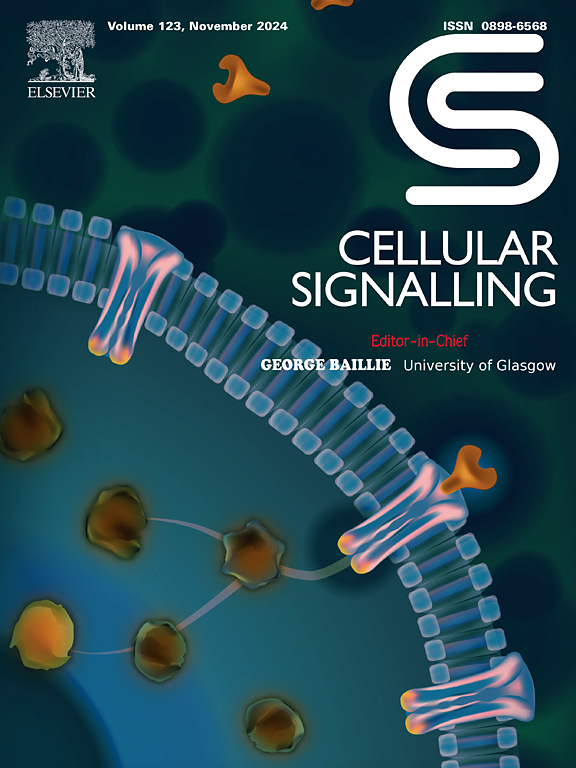抑制DJ-1可诱导癌细胞分泌TFAM,通过促进M1巨噬细胞极化抑制肿瘤生长
IF 4.4
2区 生物学
Q2 CELL BIOLOGY
引用次数: 0
摘要
DJ-1又称PARK7 (Parkinson's disease protein 7),参与细胞活力、凋亡、转录调控、氧化应激适应等过程,也参与包括癌变在内的多种人类疾病的发病机制。在这里,我们旨在确定DJ-1抑制肿瘤生长的新机制。我们的研究结果表明,在癌细胞中,DJ-1敲低可促进线粒体转录因子a (TFAM)分泌到细胞培养基中。DJ-1敲低可促进p53易位至线粒体,刺激线粒体内在凋亡通路,导致TFAM释放。此外,DJ-1敲低诱导sirtuin 3 (SIRT3)下调,从而增加TFAM的乙酰化并触发其释放。此外,我们发现细胞外TFAM通过上调癌细胞中趋化因子(CC motif)配体4 (CCL4)和趋化因子(C-X-C motif)配体5 (CXCL5)的表达,促进肿瘤微环境(TME)中M1巨噬细胞的极化,在抗肿瘤活性中发挥关键作用。最后,我们在体内证实了DJ-1抑制剂通过增加癌细胞的TFAM释放和M1巨噬细胞极化来抑制肿瘤生长。这些发现表明,DJ-1的缺失刺激凋亡依赖性的TFAM分泌,从而触发M1巨噬细胞极化,这表明通过干扰DJ-1在癌症治疗中的功能是一种新的治疗策略。本文章由计算机程序翻译,如有差异,请以英文原文为准。

Inhibition of DJ-1 induces TFAM secretion from cancer cells to suppress tumor growth via promoting M1 macrophage polarization
DJ-1, also known as PARK7 (Parkinson's disease protein 7), which is involved in cell viability, apoptosis, transcriptional regulation, and oxidative stress adaptation, is also involved in the pathogenesis of various human diseases including carcinogenesis. Here, we aimed to determine the novel mechanism by which DJ-1 inhibition suppresses tumor growth. Our results showed that DJ-1 knockdown in cancer cells promoted the secretion of a significantly larger amount of mitochondrial transcription factor A (TFAM) into the cell culture medium. DJ-1 knockdown promotes p53 translocation to the mitochondria and stimulates the intrinsic mitochondrial apoptosis pathway, resulting in TFAM release. Moreover, DJ-1 knockdown induced the downregulation of sirtuin 3 (SIRT3), which increased the acetylation of TFAM and triggered its release. Furthermore, we found that extracellular TFAM played a critical role in antitumor activity by upregulating the expression of chemokine (C![]() C motif) ligand 4 (CCL4) and chemokine (C-X-C motif) ligand 5 (CXCL5) in cancer cells, contributing to the promotion of M1 macrophage polarization in the tumor microenvironment (TME). Finally, we confirmed that the DJ-1 inhibitor suppressed tumor growth by increasing TFAM release from cancer cells and M1 macrophage polarization in vivo. These findings indicate that the depletion of DJ-1 stimulates apoptosis-dependent TFAM secretion that triggers M1 macrophage polarization, indicating a new therapeutic strategy by interfering with the DJ-1 function in cancer therapy.
C motif) ligand 4 (CCL4) and chemokine (C-X-C motif) ligand 5 (CXCL5) in cancer cells, contributing to the promotion of M1 macrophage polarization in the tumor microenvironment (TME). Finally, we confirmed that the DJ-1 inhibitor suppressed tumor growth by increasing TFAM release from cancer cells and M1 macrophage polarization in vivo. These findings indicate that the depletion of DJ-1 stimulates apoptosis-dependent TFAM secretion that triggers M1 macrophage polarization, indicating a new therapeutic strategy by interfering with the DJ-1 function in cancer therapy.
求助全文
通过发布文献求助,成功后即可免费获取论文全文。
去求助
来源期刊

Cellular signalling
生物-细胞生物学
CiteScore
8.40
自引率
0.00%
发文量
250
审稿时长
27 days
期刊介绍:
Cellular Signalling publishes original research describing fundamental and clinical findings on the mechanisms, actions and structural components of cellular signalling systems in vitro and in vivo.
Cellular Signalling aims at full length research papers defining signalling systems ranging from microorganisms to cells, tissues and higher organisms.
 求助内容:
求助内容: 应助结果提醒方式:
应助结果提醒方式:


